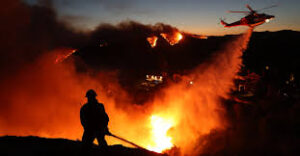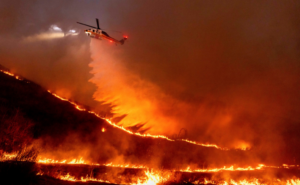








The 2025 Los Angeles Fires: Examining the Cumulative Causes
Author
Malik White | Environmental Analyst | Environmental Solutions Limited
Introduction
California has a long history of wildfires, with an increasing number of incidents in recent years. According to the California Department of Forestry and Fire Protection (CAL FIRE), over 8,000 wildfires were reported in 2022 alone, destroying more than 380,000 acres of land. The National Interagency Fire Center (NIFC) has identified California as one of the most wildfire-prone states in the U.S., where a combination of climatic factors and urban expansion contribute to frequent and devastating wildfires.
The 2025 Los Angeles fires were particularly severe, spreading rapidly across the region and exposing vulnerabilities in wildfire management. This blog examines the specific conditions that led to the fires’ aggressive spread, focusing on climate change, fuel availability, topography, and urban development. Understanding these factors is crucial for developing effective mitigation strategies to prevent future disasters.
Background of Fires in California
A Brief History of Wildfires in California
Wildfires are a natural part of California’s ecological history, playing an essential role in ecosystem renewal. However, the increasing frequency and severity of wildfires have raised concerns about fire management and prevention. Notable fires in recent history include:
2018 Camp Fire: The deadliest and most destructive wildfire in California history, burning over 153,000 acres and resulting in 85 fatalities.
2020 August Complex Fire: The largest recorded wildfire in California, burning over 1 million acres.
2025 Los Angeles Fires: Marked by rapid spread and extensive damage due to compounded factors, revealing weaknesses in disaster preparedness and urban planning.
Common Causes of Wildfires
Wildfires in California result from both natural and human-induced factors:
Natural Causes: Lightning strikes, prolonged drought, and high temperatures create conditions conducive to fire ignition.
Human Causes: Power line failures, unattended campfires, arson, and urban expansion into fire-prone areas significantly increase wildfire occurrences. According to CAL FIRE, over 90% of wildfires in California are human-caused.
Duration and Impact of Wildfires
California’s fire season typically extends from late spring to early fall, though climate change has lengthened the fire season, leading to more prolonged and intense wildfires. The economic, environmental, and social impacts of wildfires are substantial:
Economic: Firefighting costs, property losses, and insurance claims exceed billions of dollars annually.
Environmental: Wildfires destroy habitats, reduce biodiversity, and worsen air quality through smoke and particulate matter emissions.
Social: Thousands of residents face displacement, psychological trauma, and loss of life.
Compound Causes of the 2025 Los Angeles Fires
Climate Change and Its Role in Fire Spread
Impact of Santa Ana Winds
Santa Ana winds are strong, dry gusts that intensify fire behavior, pushing flames rapidly across landscapes. These winds can reach speeds exceeding 60 mph, drying vegetation and spreading embers over long distances. During the 2025 fires, the Santa Ana winds made aerial firefighting nearly impossible, as water drops were dispersed unpredictably.
Rising Temperatures and Changing Precipitation Patterns
Climate change has exacerbated wildfire conditions by increasing temperatures and altering precipitation patterns. Higher temperatures dry out vegetation, creating an abundant fuel source for fires. Additionally, shifting precipitation trends have led to cycles of extreme drought followed by wet periods that encourage excessive vegetation growth, which later dries out and becomes highly flammable.
Urban Development and Fire Risk
Housing Design and Spacing
Urban expansion into fire-prone areas has contributed to increased wildfire risks. Many residential structures are built with highly flammable materials and are closely spaced, allowing fires to spread quickly. The lack of fire-resistant construction materials and poor urban planning played a significant role in the 2025 Los Angeles fires’ rapid escalation.
Infrastructure Failures
Issues such as dry hydrants and outdated firefighting infrastructure hindered containment efforts. Many hydrants in the affected areas failed due to insufficient water pressure or lack of maintenance, preventing firefighters from effectively battling the flames.
Topography and Fire Spread
Los Angeles is characterized by a complex topographical landscape, including coastal plains, inland valleys, and mountain ranges such as the Santa Monica and San Gabriel Mountains. These features significantly influence wildfire behavior in several ways:
Steep Slopes: Fires spread more rapidly uphill due to preheating vegetation and increased wind speed along slopes.
Canyons and Ravines: These funnel winds, intensifying fire behavior and creating unpredictable spread patterns.
Urban-Wildland Interface: The proximity of natural vegetation to urban areas increases the risk of fires encroaching upon populated regions.
Multiple Fire Ignitions and Resource Strain
Simultaneous Small Fires Across the City
The 2025 fires were characterized by multiple ignition points, likely caused by power line failures and human negligence. These simultaneous ignitions overwhelmed firefighting resources, making containment efforts more difficult.
Limited Air Support Due to Strong Winds
The presence of strong Santa Ana winds during the fires restricted aerial firefighting operations. Helicopters and planes were unable to safely drop water or fire retardants, significantly slowing containment efforts. Such conditions also posed severe challenges for ground firefighters, as flames could change direction suddenly, making it difficult to establish containment lines.
Climate change has exacerbated these issues by increasing the frequency and intensity of extreme weather events. Rising temperatures result in drier conditions, increasing the risk of ignition and promoting the availability of dry fuel sources. Changing precipitation patterns have led to periods of extreme drought followed by intense rainfall, causing excessive vegetation growth that later dries out and becomes highly flammable.
Conclusion and Mitigation Strategies
The 2025 Los Angeles fires underscore the critical need for improved wildfire preparedness and management. The combination of climate change, urban expansion, and infrastructure failures contributed to the rapid spread and difficulty in containment. Mitigation strategies should focus on:
Enhancing fire-resistant urban planning and building codes to reduce fire spread in residential areas.
Upgrading firefighting infrastructure, including reliable water sources and better-equipped hydrants.
Strengthening early warning and evacuation systems to minimize human casualties.
Implementing stricter regulations on human activities that increase fire risks, such as power line maintenance and controlled burns.
Investing in climate adaptation strategies to address the long-term impacts of increasing temperatures and shifting weather patterns.
Understanding the multifaceted causes of wildfires is essential to reducing future risks and improving resilience against these destructive natural disasters. By addressing the complex interplay of climate, urban development, and emergency response strategies, California can better prepare for and mitigate the impacts of future wildfires.

